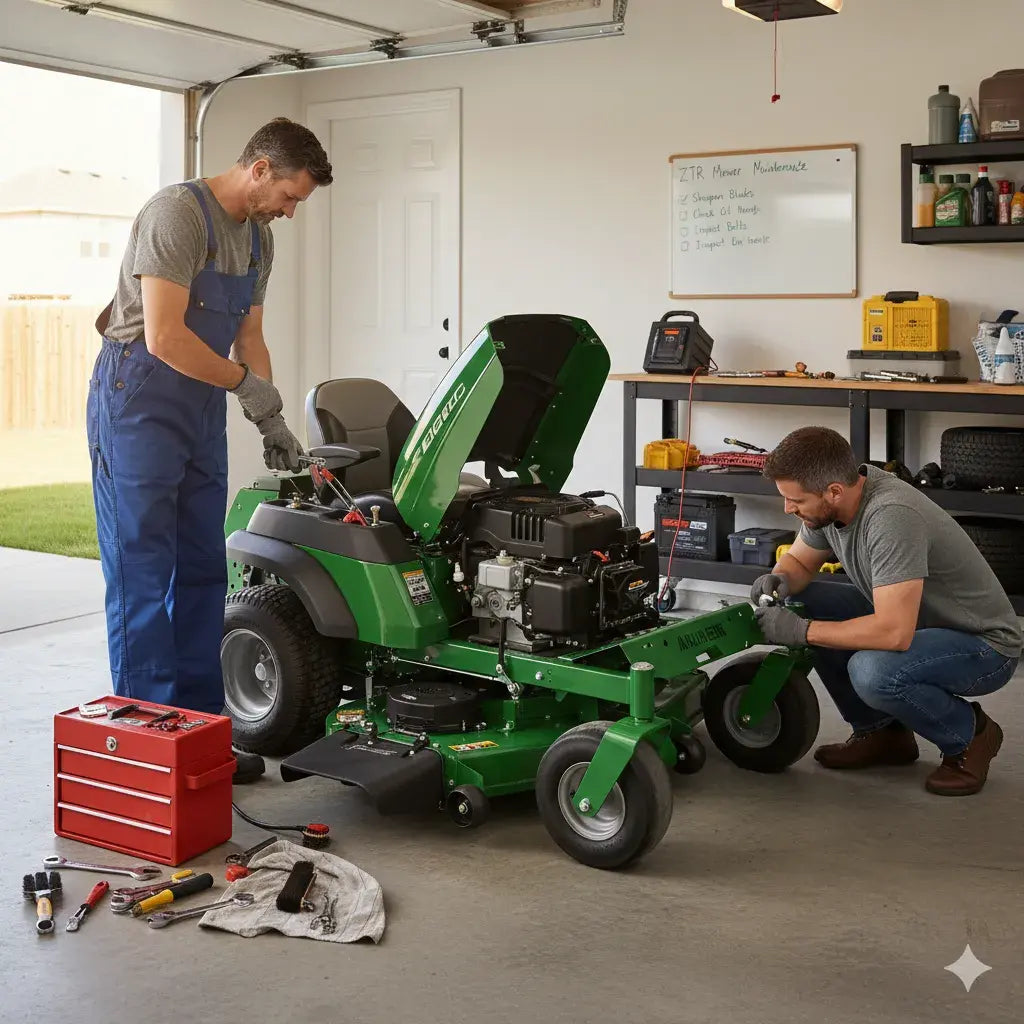
How to Troubleshoot Common Issues with Zero Turn Mowers
Share
Owning a zero turn mower can make maintaining your lawn faster and much more efficient, but even the most reliable machines can develop issues over time. Maybe it won’t start, the blades aren’t cutting evenly, or the battery doesn’t seem to hold a charge. Knowing how to handle these problems before they turn into bigger headaches is essential. That’s where zero turn mower troubleshooting comes in. In this guide, we’ll walk you through practical, easy-to-follow solutions to the most common mower issues so you can keep your lawn looking great without unnecessary stress.
1. Mower Won’t Start

There’s nothing more frustrating than getting ready to tackle your lawn, only to discover your zero turn mower refuses to start. The good news is that, in most cases, the problem is simple and can be fixed quickly once you know where to look. Learning basic zero turn mower troubleshooting for starting issues can save you both time and a costly trip to the repair shop.
Check the Battery
For electric or battery-powered mowers, a dead or weak battery is often the culprit. Start by making sure your battery is fully charged. It’s easy to overlook loose or corroded connections, but cleaning the terminals and securing the cables can make a world of difference. In many cases, a simple battery check is all that’s needed to get your mower up and running.
Inspect the Spark Plug
Gas-powered mowers rely on a properly functioning spark plug. If the engine struggles to ignite, the spark plug could be dirty, worn, or damaged. Carefully remove it and look for signs of buildup or cracks. Cleaning it with a wire brush or swapping it for a new plug can often restore smooth starting and even improve engine performance.
Check Safety Switches and Controls
Zero turn mowers are designed with safety in mind, which means they won’t start if certain controls aren’t in the correct position. Make sure the parking brake is set, your seat switch is engaged, and the mower is in neutral. These small steps are easy to miss, but they’re often the reason your mower won’t start.
Pro Tip: Even if everything seems fine, schedule a quick battery and spark plug inspection at the start of each mowing season. Preventive care is the easiest way to avoid frustrating delays and keep your mower ready whenever you need it.
2. Uneven or Poor Cutting

Nothing ruins the look of a freshly mowed lawn faster than uneven patches or ragged edges. Fortunately, most cutting problems are easy to identify and fix if you know what to check. Understanding zero turn mower troubleshooting for cutting issues can help you get a consistently neat lawn every time.
Inspect and Sharpen Blades
One of the most common causes of poor cutting is dull or damaged blades. Over time, blades can become nicked, bent, or worn down, making it harder for your mower to slice through grass cleanly. Remove the blades carefully and inspect them for damage. Sharpening them regularly—or replacing them when needed—will make a noticeable difference in how even your lawn looks.
Check Deck Leveling
An unlevel mower deck is another frequent culprit behind uneven cuts. If one side is higher than the other, your mower won’t cut the grass consistently. Use a leveling tool or follow the manufacturer’s instructions to adjust the deck height, making sure all four corners sit evenly. Even a small adjustment can dramatically improve your mowing results.
Adjust Mowing Speed and Grass Height
Sometimes, the problem isn’t the mower—it’s how you’re using it. Mowing too quickly can leave strips of uncut grass, especially if your lawn is thick or damp. Similarly, cutting grass that’s too tall in a single pass can strain your mower and result in an uneven finish. Slow down your pace and adjust the deck height to match the grass length for the smoothest cut.
Pro Tip: Pay attention to how your lawn reacts after each mow. Small tweaks to blade sharpness, deck level, and mowing speed can prevent recurring cutting problems and keep your lawn looking its best all season.
3. Slow Movement or Hesitation in Your Mower

If your mower is moving slowly or hesitating during operation, it’s usually a sign that maintenance is needed. Here’s how to fix it:
1. Inspect the Transmission and Belts
Over time, belts and pulleys can wear out, and the transmission system may lose efficiency. Check for loose, frayed, or damaged belts, and make sure the transmission is properly lubricated and maintained. Proper belt tension and a well-maintained transmission help your mower run smoothly.
2. Check Tires and Wheel Bearings
Low tire pressure or worn wheel bearings can reduce your mower’s speed and performance. Inflate tires to the manufacturer’s recommended pressure and inspect bearings for signs of wear. Replacing worn bearings ensures smooth movement and prevents further damage.
3. Remove Debris from Deck and Wheels
Grass clippings, dirt, and other debris can accumulate under the mower deck and around the wheels, creating drag and slowing down your mower. Clean the deck, wheels, and undercarriage regularly to maintain optimal performance. Keeping these areas clear improves efficiency and extends the life of your mower.
4. Battery and Electrical Problems in Electric Zero-Turn Mowers

Electric zero-turn mowers are convenient, but they rely on a properly functioning battery and electrical system. If your mower is struggling to start or loses power during operation, here’s how to identify and fix common issues:
1. Check Battery Connections
The most common cause of electrical problems is a loose or corroded battery terminal. Make sure the battery cables are securely attached and free of corrosion. If you notice white or greenish buildup, clean it carefully with a wire brush. Tight, clean connections are critical for your mower to start and run reliably.
2. Test the Battery
Even if the connections look fine, the battery itself may be weak. Use a multimeter to check the voltage. A fully charged 12V battery should read around 12.6 volts or higher. If the voltage drops significantly under load, it’s time to replace the battery. Using a weak battery can cause inconsistent performance and shorten the mower’s lifespan.
3. Inspect Wiring and Fuses
Worn, frayed, or disconnected wires can disrupt the mower’s electrical flow. Carefully check all visible wiring for damage. Also, inspect fuses and replace any that are blown. Replacing damaged wires and fuses ensures the mower receives steady power and prevents unexpected shutdowns.
Pro Tip: Always remove the key and disconnect the battery before inspecting electrical components. This prevents accidental shorts or shocks while you troubleshoot.
5. Engine or Mechanical Noise

Imagine you’re mowing your lawn, and suddenly you hear a grinding or rattling sound coming from your zero turn mower. It can be alarming, but these noises are usually your mower’s way of signaling that something needs attention. Ignoring them can turn a small issue into a costly repair, so it’s important to act quickly.
Figure Out Where the Sound Is Coming From
The first step is to locate the source. Safety comes first: make sure the blades are disengaged and the mower is on a flat surface. Listen closely—does the noise come from the engine, the wheels, or under the deck? Even a small vibration can give clues about what’s wrong.
Inspect Belts, Blades, and Other Parts
Once you know where the noise originates, check the related components. Loose bolts, worn belts, and bent or unbalanced blades are common culprits. For example, a slightly misaligned blade can create a rhythmic vibration that sounds worse than it is, but tightening or replacing it can eliminate the noise. Likewise, worn belts or loose screws around the deck or engine area can create rattles or squeaks.
Keep Up With Preventive Maintenance
Most noise problems can be avoided with regular care. Wipe away grass and debris from under the deck, lubricate moving parts like spindles and wheel bearings, and inspect belts and bolts at least once a month. These small steps help your mower run smoothly, quietly, and efficiently, and they prevent minor issues from turning into major repairs.
Pro Tip: If you notice a new sound, don’t wait. Take a few minutes to inspect the mower and fix the issue while it’s still small. Treating these noises early is much easier than dealing with a complete mechanical breakdown.
Preventive Maintenance for Your Zero-Turn Mower
Keeping your zero-turn mower in top condition doesn’t have to be complicated. A few simple, consistent steps can prevent most problems and make your mower last longer.
1. Take Care of the Blades
Dull or damaged blades can tear grass instead of cutting it cleanly, putting extra stress on your mower. Check your blades regularly, sharpen them if needed, and replace any that are bent or chipped. You’ll get a smoother cut and save your engine from unnecessary strain.
2. Look After the Battery
For electric mowers, the battery is the heart of the machine. Always charge it fully before use and make sure the terminals are clean and free of corrosion. A secure, well-maintained battery keeps your mower running reliably and avoids frustrating power loss mid-job.
3. Keep the Deck Clean
Grass and dirt build up quickly under the mower deck. After each use, clear away clippings and debris. This prevents rust, reduces drag, and ensures a cleaner, more efficient cut next time you mow.
4. Lubricate Moving Parts
Wheels, spindles, and other moving parts need regular lubrication. Check your owner’s manual for the right oil or grease points, and apply as recommended. This reduces wear, cuts down on noise, and helps your mower operate smoothly.
5. Do Regular Inspections
Even with daily care, small issues can develop. Once a month, inspect belts, tires, and engine components. Tighten loose parts, replace worn items, and make sure everything is in proper working order. Catching minor problems early saves time and money down the road.
Pro Tip: Keep a small notebook or checklist for your zero-turn mower maintenance. It’s a simple way to stay on top of care tasks and avoid surprises during mowing season.
